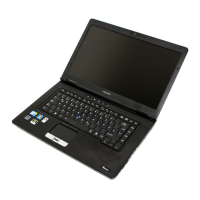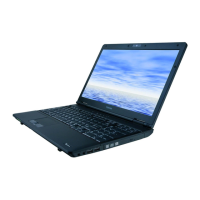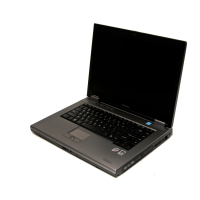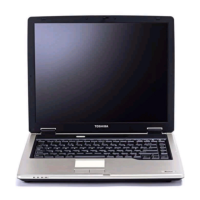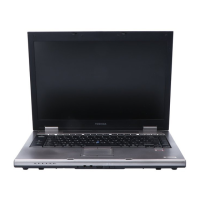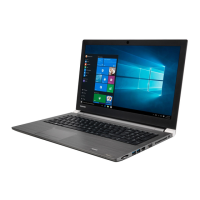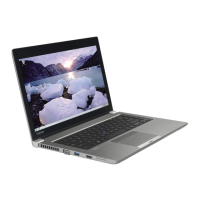Do you have a question about the Toshiba TECRA A10 and is the answer not in the manual?
Lists all items included in the computer package for verification.
Details how to connect the AC adapter for power and battery charging.
Explains how to turn the computer on and the different modes for turning it off.
Identifies components on the front of the computer when the display is closed.
Identifies components and ports on the left side of the computer.
Identifies components and ports on the right side of the computer.
Identifies ports and indicators on the back of the computer.
Identifies components on the underside of the computer.
Identifies components on the front of the computer when the display is open.
Explains the function of various LED system indicators on the computer.
Describes the AC adapter, its specifications, and usage precautions.
Details the specifications of the Intel processors used in the computer.
Covers memory slots, video RAM, and battery pack specifications.
Describes hard disk/SSD types, optical drives, and display panel specifications.
Explains sound system, web camera, modem, and LAN capabilities.
Highlights unique or advanced features like Assist, Presentation buttons, and hot keys.
Describes pre-installed utilities like Fingerprint, Face Recognition, and DVD Player.
Lists optional devices such as PC Cards, Smart Cards, and memory modules.
Explains the use of the Touch Pad and AccuPoint pointing stick.
Details how to enroll, authenticate, and manage fingerprints using the sensor.
Describes the functionality and usage precautions for the built-in web camera.
Explains how to register, use, and manage face recognition for login.
Covers loading, removing, and using CD/DVD drives.
Provides instructions and precautions for writing data to CDs and DVDs.
Explains the basic alphanumeric and punctuation keys on the keyboard.
Describes the twelve function keys and their programmable operations.
Explains how the FN key combines with other keys to activate special features.
Details specific key combinations for quick system configuration and feature control.
Describes keys with special functions within the Windows operating system.
Explains how to use the numeric keypad overlay for data entry and cursor control.
Explains the computer's power states and the meaning of status indicators.
Covers battery types, charging, usage, and safety precautions.
Provides tips to extend the battery life and operating time.
Instructions on how to launch the TOSHIBA HW Setup program.
Describes BIOS version, factory settings, and display configuration options.
Explains how to set the order of devices for computer booting.
Covers processor operating modes and Wake-up on LAN functionality.
Details settings for hardware device configuration, including USB emulation.
Provides guidelines for effectively diagnosing and resolving computer problems.
Lists basic checks for common issues before detailed troubleshooting.
Offers questions to guide the user in identifying the source of a computer malfunction.
Provides a checklist of hardware and peripheral areas where problems may occur.
Guides troubleshooting for issues related to the AC adapter and power supply.
Details common battery issues and their solutions.
Covers common keyboard issues like incorrect character output or key malfunctions.
Addresses problems with the display panel, such as no display or markings.
Guides troubleshooting for issues related to booting from the hard disk drive.
Covers issues with accessing or reading data from CD/DVD drives.
Addresses issues with the USB mouse, such as pointer not responding or double-clicking.
Covers troubleshooting for fingerprint reading failures and injuries.
Troubleshoots issues with accessing the Local Area Network.
Addresses problems with connecting to or using the Wireless LAN.
Provides guidance on contacting TOSHIBA for technical assistance and problem resolution.
Details the ambient temperature, humidity, and altitude specifications for operation.
Lists the AC adapter and computer power input specifications.
Provides detailed communication system, protocol, and speed specifications for the modem.
Explains how the display controller interprets software commands for screen output.
Describes how video mode settings affect screen resolution and color display.
Details the form factor, compatibility, OS support, and access protocol.
Explains how country, product type, and environment affect wireless signal range.
Lists supported 5 GHz and 2.4 GHz channels and regulatory information.
Lists compliance with Bluetooth specifications and logo certification.
Warns about potential interference between Bluetooth and Wireless LAN devices.
Discusses the safety and usage recommendations for Bluetooth technology.
Details FCC compliance and measures to correct radio frequency interference.
Lists the required specifications for power cords, including length, wire size, and rating.
Lists various international certification agencies for electrical safety and compliance.
Explains how to set up a timer-activated BIOS password to prevent unauthorized access.
Provides methods to start the PC Health Monitor software.
Details the procedure for cleaning the computer's cooling module.
Lists conditions that may affect CPU performance, like environment and usage.
Outlines hardware and software requirements for 64-bit computing.
Discusses factors affecting battery life and its natural degradation.
Clarifies the difference between gigabyte definitions and factors affecting usable capacity.
Lists essential information required to identify the computer for theft reporting.
Provides instructions for reporting a stolen computer via paper form or online database.
Lists all items included in the computer package for verification.
Details how to connect the AC adapter for power and battery charging.
Explains how to turn the computer on and the different modes for turning it off.
Identifies components on the front of the computer when the display is closed.
Identifies components and ports on the left side of the computer.
Identifies components and ports on the right side of the computer.
Identifies ports and indicators on the back of the computer.
Identifies components on the underside of the computer.
Identifies components on the front of the computer when the display is open.
Explains the function of various LED system indicators on the computer.
Describes the AC adapter, its specifications, and usage precautions.
Details the specifications of the Intel processors used in the computer.
Covers memory slots, video RAM, and battery pack specifications.
Describes hard disk/SSD types, optical drives, and display panel specifications.
Explains sound system, web camera, modem, and LAN capabilities.
Highlights unique or advanced features like Assist, Presentation buttons, and hot keys.
Describes pre-installed utilities like Fingerprint, Face Recognition, and DVD Player.
Lists optional devices such as PC Cards, Smart Cards, and memory modules.
Explains the use of the Touch Pad and AccuPoint pointing stick.
Details how to enroll, authenticate, and manage fingerprints using the sensor.
Describes the functionality and usage precautions for the built-in web camera.
Explains how to register, use, and manage face recognition for login.
Covers loading, removing, and using CD/DVD drives.
Provides instructions and precautions for writing data to CDs and DVDs.
Explains the basic alphanumeric and punctuation keys on the keyboard.
Describes the twelve function keys and their programmable operations.
Explains how the FN key combines with other keys to activate special features.
Details specific key combinations for quick system configuration and feature control.
Describes keys with special functions within the Windows operating system.
Explains how to use the numeric keypad overlay for data entry and cursor control.
Explains the computer's power states and the meaning of status indicators.
Covers battery types, charging, usage, and safety precautions.
Provides tips to extend the battery life and operating time.
Instructions on how to launch the TOSHIBA HW Setup program.
Describes BIOS version, factory settings, and display configuration options.
Explains how to set the order of devices for computer booting.
Covers processor operating modes and Wake-up on LAN functionality.
Details settings for hardware device configuration, including USB emulation.
Provides guidelines for effectively diagnosing and resolving computer problems.
Lists basic checks for common issues before detailed troubleshooting.
Offers questions to guide the user in identifying the source of a computer malfunction.
Provides a checklist of hardware and peripheral areas where problems may occur.
Guides troubleshooting for issues related to the AC adapter and power supply.
Details common battery issues and their solutions.
Covers common keyboard issues like incorrect character output or key malfunctions.
Addresses problems with the display panel, such as no display or markings.
Guides troubleshooting for issues related to booting from the hard disk drive.
Covers issues with accessing or reading data from CD/DVD drives.
Addresses issues with the USB mouse, such as pointer not responding or double-clicking.
Covers troubleshooting for fingerprint reading failures and injuries.
Troubleshoots issues with accessing the Local Area Network.
Addresses problems with connecting to or using the Wireless LAN.
Provides guidance on contacting TOSHIBA for technical assistance and problem resolution.
Details the ambient temperature, humidity, and altitude specifications for operation.
Lists the AC adapter and computer power input specifications.
Provides detailed communication system, protocol, and speed specifications for the modem.
Explains how the display controller interprets software commands for screen output.
Describes how video mode settings affect screen resolution and color display.
Details the form factor, compatibility, OS support, and access protocol.
Explains how country, product type, and environment affect wireless signal range.
Lists supported 5 GHz and 2.4 GHz channels and regulatory information.
Lists compliance with Bluetooth specifications and logo certification.
Warns about potential interference between Bluetooth and Wireless LAN devices.
Discusses the safety and usage recommendations for Bluetooth technology.
Details FCC compliance and measures to correct radio frequency interference.
Lists the required specifications for power cords, including length, wire size, and rating.
Lists various international certification agencies for electrical safety and compliance.
Explains how to set up a timer-activated BIOS password to prevent unauthorized access.
Provides methods to start the PC Health Monitor software.
Details the procedure for cleaning the computer's cooling module.
Lists conditions that may affect CPU performance, like environment and usage.
Outlines hardware and software requirements for 64-bit computing.
Discusses factors affecting battery life and its natural degradation.
Clarifies the difference between gigabyte definitions and factors affecting usable capacity.
Lists essential information required to identify the computer for theft reporting.
Provides instructions for reporting a stolen computer via paper form or online database.
| Processor | Intel Core 2 Duo |
|---|---|
| RAM | Up to 4GB DDR2 |
| Graphics | Intel GMA 4500MHD |
| Chipset | Intel GM45 Express |
| Optical Drive | DVD SuperMulti Drive |
| LAN | Gigabit Ethernet |
| Display | 15.4-inch |
| Storage | Up to 320GB HDD |
| Operating System | Windows Vista Business |
| Weight | 2.7 kg |
| Wireless | 802.11a/g/n |
| Ports | VGA |
